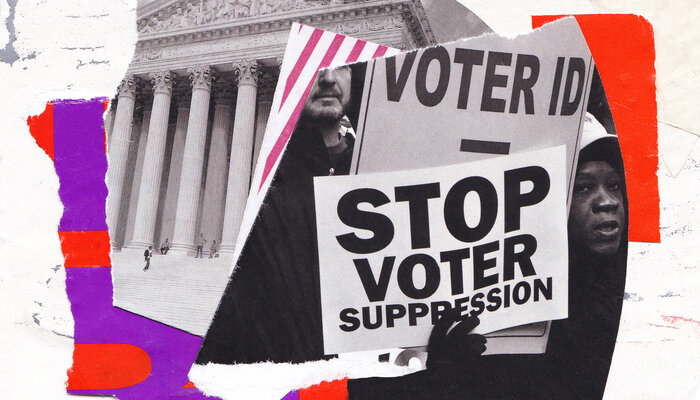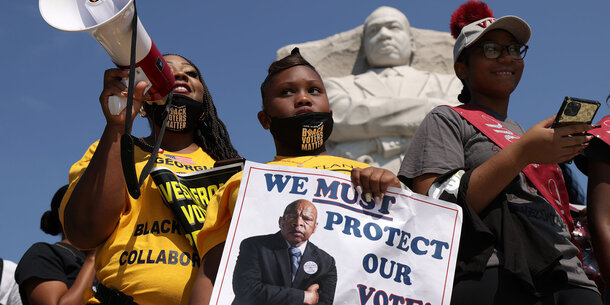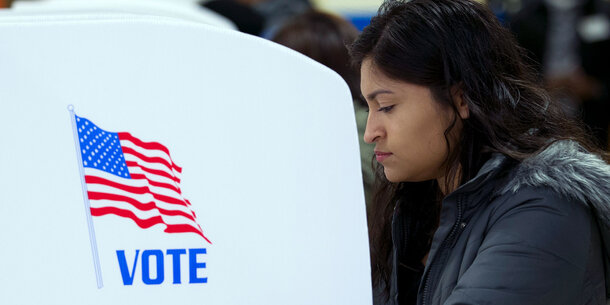How to Restore and Strengthen the Voting Rights Act
If enacted, the John Lewis Voting Rights Advancement Act would help protect voters from racial discrimination and vote suppression.

Enacted in 1965, the Voting Rights Act (VRA) prohibits racial discrimination in elections, and the landmark law is considered a signature achievement of the civil rights movement. But the Supreme Court’s 2013 ruling in Shelby v. Holder significantly weakened the VRA’s protections, clearing the path for states to pass a slew of laws that disenfranchise voters and discriminate against voters of color.
One effort to reverse this trend is the John Lewis Voting Rights Advancement Act. Named in honor of the late civil rights icon and longtime congressman, the bill aims to combat racial discrimination in voting by restoring and strengthening the protections of the VRA.
How significant was the enactment of the VRA and what did it accomplish?
Myrna Pérez: The VRA is a crown jewel of progress in the United States. It was a tangible representation of the promise that we made when we passed the 15th Amendment — that Americans would be free from racial discrimination when voting. Until that point, it is indisputable that the country had not lived out those promises.
Additionally, the VRA was a key achievement of an incredible civil rights movement led by brave women and men who put a lot on the line to make our country more consistent with our ideals and values. Undeniably, there had been a lot of resistance to an open and fair and accessible democracy. When the VRA was passed, it gave us both an important commitment by the country to be a fairer and more equal place, and the legal teeth to go after vote suppressors and to enforce more protections.
The VRA includes a number of important provisions, with Section 2 and Section 5 garnering the most recent conversation. Section 2, which is nationwide in its coverage, targets policies and practices that impede the ability of communities of color to elect the candidates of their choices. Section 5, also known as preclearance, required states and jurisdictions with a proven historical record of discriminatory voting practices to obtain certification before making changes to election procedures that the proposed changes were not discriminatory. The preclearance set up a pretty simple administrative regime in which jurisdictions could get that certification from the Department of Justice or from a court. For nearly 50 years, this helped protect voters of color in jurisdictions with a history of racial discrimination.
What was Shelby v. Holder and how has it affected the VRA?
Pérez: Preclearance came to a crashing halt with the Supreme Court’s 2013 decision in Shelby County v. Holder, which concluded that Congress was using an outdated formula to decide which states and jurisdictions were required to go through the preclearance process. And so, we still have preclearance on the books — but no state or jurisdiction currently has to abide by it.
The Shelby ruling was a very hard pill to swallow for several reasons. It defied people’s lived experiences of racial discrimination and voter suppression. It seemed to fly in the face of other Supreme Court decisions that had been very clear that Section 5 was constitutional and appropriate. And it ignored Congress’ very broad power and the deep record of discrimination amassed when reauthorizing the VRA — most recently in 2006, with almost unanimous support. So, Shelby felt very out of step not only with Americans but also with Congress and the courts.
We have seen the impact of the Shelby decision. We’ve seen more states pass new voting restrictions. We have seen states use policies and practices to make it harder to vote. We’ve seen states increase voter purges. And the 2020 election made clear that voter suppression is still live and real, and that there are politicians who are determined to manipulate the rules of the game so that some people can participate, and some people can’t.
So, we need to have the protections of the VRA in place. Americans deserve an election system that is free from racial discrimination in voting. And we need a functioning Section 5. We need a functioning preclearance regime.
How will the John Lewis Voting Rights Advancement Act restore and strengthen the protections of the VRA?
Pérez: The John Lewis Voting Rights Advancement Act is responsive to what the Supreme Court’s Shelby decision said needed to be done. It has a new coverage formula that looks at more modern issues of discrimination. It has a provision that looks at particular practices that have been trouble in the past and sets forth criteria for which those practices are subject to preclearance. It has procedures for states or jurisdictions to show that preclearance does not make sense any more for them. It has additional notice and transparency opportunities. And it sets forth practices for federal observers, so that voters get support from the federal government if there are problems on the ground.
How does the Brennan Center’s work on democracy reform intersect with the push to restore the VRA?
Pérez: The VRA is an extraordinarily high priority for the Brennan Center. We’re very proud of the work we did alongside our partners to preserve the VRA pre-Shelby and we are very proud to be with a group of dedicated civil rights organizations working to restore the VRA.
The Shelby effort required a nationwide amicus and public campaign that so many civil rights organizations mobilized for. But there was also a predecessor case — NAMUDNO v. Holder — that teed up Shelby, and many of us were active there as well.
When Shelby came down, we and our partners jumped into gear to try and come up with a new proposal that was responsive to the Court and its criticisms. That effort still continues. We’re still pushing for the legislation, trying to do research that demonstrates its importance, still working with our partners on it, still talking to staffers and members on the Hill about it either in small groups or via testimony, and still doing a lot of public education on the importance of the VRA. We’re making the case whenever we can to whoever will listen (and even some who may not) that we need a strong and robust Voting Rights Act.
And, importantly, these efforts fit together with another Brennan Center legislative priority — the For the People Act.
The For the People Act (H.R. 1 in the House and S. 1 in the Senate) deals with a lot of nuts-and-bolts election administration issues, while the John Lewis Voting Rights Advancement Act deals with the particular pathology of racial discrimination in voting. The For the People Act is likely to help communities of color, which are typically the hardest hit by the burdens that get imposed as a result of election administration or voter suppression problems. The John Lewis Voting Rights Advancement Act directly targets the issue of racism and discrimination in our electoral process.
It is important for our country’s culture, progress, advancement, unity, and healing to recognize that we still have racial discrimination in voting and that we are going to say in one very clear and resounding voice as a country: We don’t want it. It’s not something we’re going to tolerate. It’s not something we think is OK.
What’s the path forward for the John Lewis Voting Rights Advancement Act?
Pérez: Our country is reeling from the attack on our Capitol, from the assault on our elections, and from naked voter suppression and discrimination. This is an important time to remember what can happen if we don’t have guardrails in place. The John Lewis Voting Rights Advancement Act is one obvious way to impose these guardrails. It has already been passed by the House before. We now have an administration that is supportive of it. We now have a Justice Department that is headed by people who know how important voting rights are. It’s now up to Americans to tell Congress that we don’t want to wait any longer. We need a strong bill.
It’s also important for the courts to take an account of what happened after Shelby, and just how wrong the implication was that there is no longer any racism and discrimination at the ballot box — because we continue to see it. And we know how certain politicians will react when their power is threatened, and how low they will stoop to try and maintain the power that they have rather than respecting America’s multiracial democracy.
How do these efforts fit into John Lewis’s vision for America?
Pérez: John Lewis knew the importance of voting rights. He demanded it. He fought for it. He spoke out against voter suppression. And an op-ed he wrote shortly before his death, he talked about the importance of the voting rights. He is an important reminder of how far this country has come, an important reminder of how far we can go when we limit the influence of discrimination in voting. This bill honors his legacy.






